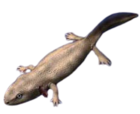
A | B | C | D | E | F | G | H | CH | I | J | K | L | M | N | O | P | Q | R | S | T | U | V | W | X | Y | Z | 0 | 1 | 2 | 3 | 4 | 5 | 6 | 7 | 8 | 9
| Grandisoniidae | |
|---|---|

| |
| Scientific classification | |
| Domain: | Eukaryota |
| Kingdom: | Animalia |
| Phylum: | Chordata |
| Class: | Amphibia |
| Order: | Gymnophiona |
| Clade: | Apoda |
| Family: | Grandisoniidae Lescure, Renous & Gasc, 1986 |
| Genera | |
|
Gegeneophis | |
The Grandisoniidae are a family of common caecilians found in Africa, Seychelles and India.[1][2] Like other caecilians, they superficially resemble worms or snakes. The family was formerly known as Indotyphlidae.[1]
Taxonomy
The genera in this family were originally placed in family Caeciliidae. In 2011, the genera Gegeneophis, Grandisonia, Hypogeophis, Idiocranium, Indotyphlus, Praslinia and Sylvacaecilia were segregated into family Indotyphlidae, named after the tribe Indotyphlini, which was used by Lescure et al (1986) for the Indian genera, Gegeneophis and Indotyphlus.[1][3] However, it was later pointed out that the name Grandisoniidae is the appropriate family-group name because, according to rules of the Nomenclatural Code, a name published at higher rank, Grandisoniinae, has precedence over a name of lower rank published in the same work, Indotyphlini.[4][1][2]
Genera and species
- Genus Gegeneophis
- Genus Grandisonia
- Genus Hypogeophis
- Genus Idiocranium
- Genus Indotyphlus
- Genus Praslinia
- Genus Sylvacaecilia
References
- ^ a b c d Frost, Darrel R. "Grandisoniidae". Amphibian Species of the World, an Online Reference. Version 6.0. American Museum of Natural History, New York. Retrieved 17 March 2022.
- ^ a b "Grandisoniidae". AmphibiaWeb. University of California, Berkeley. Retrieved 17 March 2022.
- ^ Wilkinson, Mark; San Mauro, Diego; Sherratt, Emma; Gower, David J. (2011). "A nine-family classification of caecilians (Amphibia: Gymnophiona)". Zootaxa. 2874 (1): 41–64. doi:10.11646/zootaxa.2874.1.3. eISSN 1175-5334. ISSN 1175-5326.
- ^ Dubois, Ohler, and Pyron, 2021, Megataxa, 5: 1–738
- Frost, Darrel R. (2019). "Indotyphlidae". Amphibian Species of the World: an Online Reference. Version 6.0. American Museum of Natural History, New York, USA. Retrieved 7 October 2019.
- AmphibiaWeb: Information on amphibian biology and conservation. . 2004. Berkeley, California: AmphibiaWeb. Available: http://amphibiaweb.org/. Retrieved 26 August 2004
Text je dostupný za podmienok Creative Commons Attribution/Share-Alike License 3.0 Unported; prípadne za ďalších podmienok. Podrobnejšie informácie nájdete na stránke Podmienky použitia.
Antropológia
Aplikované vedy
Bibliometria
Dejiny vedy
Encyklopédie
Filozofia vedy
Forenzné vedy
Humanitné vedy
Knižničná veda
Kryogenika
Kryptológia
Kulturológia
Literárna veda
Medzidisciplinárne oblasti
Metódy kvantitatívnej analýzy
Metavedy
Metodika
Text je dostupný za podmienok Creative
Commons Attribution/Share-Alike License 3.0 Unported; prípadne za ďalších
podmienok.
Podrobnejšie informácie nájdete na stránke Podmienky
použitia.
www.astronomia.sk | www.biologia.sk | www.botanika.sk | www.dejiny.sk | www.economy.sk | www.elektrotechnika.sk | www.estetika.sk | www.farmakologia.sk | www.filozofia.sk | Fyzika | www.futurologia.sk | www.genetika.sk | www.chemia.sk | www.lingvistika.sk | www.politologia.sk | www.psychologia.sk | www.sexuologia.sk | www.sociologia.sk | www.veda.sk I www.zoologia.sk




